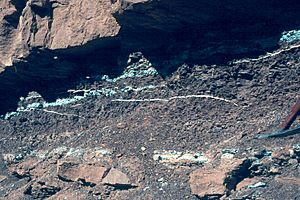Chugwater Formation facts for kids
Quick facts for kids Chugwater Formation (Group)Stratigraphic range: Triassic |
|
|---|---|

Outcrop of Chugwater Group near Thermopolis, Wyoming
|
|
| Type | sedimentary |
| Underlies | Nugget Sandstone, Morrison Formation |
| Overlies | Dinwoody Formation, Goose Egg Formation |
| Lithology | |
| Primary | sandstone |
| Other | shale, gypsum, limestone |
| Location | |
| Extent | Wyoming, Colorado, Montana |
| Type section | |
| Named for | Chugwater, Wyoming |
| Named by | N. H. Darton, 1904 |
The Chugwater Formation is a special type of rock found in the western United States. You can see it in Wyoming, Montana, and Colorado. It's mostly made of red sandstone.
In Colorado and Montana, it's called a "formation." But in Wyoming, it's known as the "Chugwater Group." A group is like a collection of different rock layers.
Scientists don't study the Chugwater Formation as much as some other rocks. This is because it doesn't have many fossils. It also sits below the famous Morrison Formation, which is full of dinosaur fossils!
Contents
What Makes the Chugwater Formation Special?
The Chugwater Formation is easy to spot because of its bright brick-red color. This color comes from tiny bits of iron minerals in the rock. These minerals have rusted, just like iron turns red when it rusts.
Sometimes, you'll see light bluish-gray streaks or spots. These are places where the iron didn't rust.
What is it Made Of?
The Chugwater Formation is mostly made of siltstone and shale. These are fine-grained rocks. It also has layers of sandstone mixed in. Even though these rocks can break easily, the Chugwater Formation is so big that you can see large parts of it sticking out of the ground.
Near the top of the formation, there's a thick layer of gypsum. Gypsum is a soft mineral often used to make plaster or drywall. You can also see thin lines of gypsum, called veins, running through the rock.
Most of the time, you can't see small patterns in the rock. This is because the gypsum crystals grew after the rock was laid down. But sometimes, you might spot ripple marks (like those left by water) or crossbedding (slanted layers). You can also often find bumpy, irregular shapes where mudcracks filled in with new sediment long ago.
The Minerals Inside
The main mineral in the Chugwater Formation is quartz. Quartz is a very hard mineral, which helps make the Chugwater rock strong. You'll also find smaller amounts of feldspars.
Other minerals include hematite, which gives the rock its red color, and gypsum. Tiny dark specks might be biotite, another mineral. All these minerals are held together by a natural "glue" that isn't made of carbonate. It's probably made of silica, which is similar to quartz.
The Chugwater Formation is a great example of "red beds." These are layers of rock that are red because they formed in dry, desert-like conditions. Many red beds were laid down during the Permian and Triassic periods.

How Old is the Chugwater Formation?
Scientists use special methods to figure out the age of rocks. These methods show that the Chugwater Formation formed during the Triassic Period. The Triassic Period was a very long time ago, from about 252 to 201 million years ago! This was when the first dinosaurs started to appear on Earth.
Where Can You Find It?
The Chugwater Formation is found in several large areas called "basins" within the Rocky Mountains. These basins include the Denver Basin, Wind River Basin, Bighorn Basin, Powder River Basin, Greater Green River Basin, and Laramie Basin.
In Wyoming, the Chugwater is a "Group" because it's made of several smaller formations. For example, in some areas, it includes the Red Peak Formation, Crow Mountain Formation, Jelm Formation, and Popo Agie Formation. The exact layers can be a bit different depending on which basin you are in.

